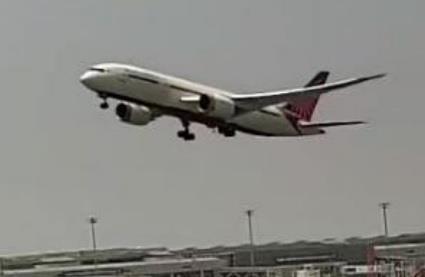- Reaction score
- 22,335
- Points
- 1,010
On every aircraft that I have been on, there is only one set of fuel shutoff switches. They are guarded switches and require a deliberate act to actuate.

I suppose. Training standards may be “iffy” in that part of the world. The dude who actuated the fuel shutoffs, may actually have thought he was doing something else. We may never know for certain.Is there any plausible way this was just a colossal oops?

It is guess work, but it is probably a mechanical system for a very good reason.Seeing as the switches have a 'stop-lock' safety (i.e. lift and re-position), it makes sense that it would have to have been a deliberate act since each switch must be manually held but probably a thumb and one finger to move. It is being reported that each switch went into cut-off about one second apart so it would seem a very quick and deliberate act.
The only unanswered question is whether the flight control computer has the ability to activate these switch. As we saw with the 737 Max series of incidents, an unintended response to inputs.
Self loading cargo question: is there one central set of switches, or one set per seat?
Because it could be "guy who cut the switches asks the other guy why he did it to leave a false record on the recorder".
Is there any plausible way this was just a colossal oops?
The only unanswered question is whether the flight control computer has the ability to activate these switch. As we saw with the 737 Max series of incidents, an unintended response to inputs.

Well that did not take long. It has only been a five days since the US got all tough on India and tried to humiliate the Indians into bowing to US greatness. Then, the Trump Administration imposed what were clearly punitive tariffs on India, expecting, it seems, the Indians to come grovelling to Trump and ask what they needed to do to make things better.
And guess what? It is already the US which is grovelling as the Indians treat the move by the Trump Administration with the disdain that it deserves.
What the Trump Administration was doing in singling out India for punitive tariffs was not just self-destructive, it was also profoundly illogical. The publicly stated idea that the move was because India was buying lots of Russian oil was, ipso facto, ridiculous. China buys even more Russian oil than India and Turkey buys almost as much—and Trump is desperately trying to keep both of these states onboard. And, as I warned in that piece, the move would more than likely help Putin by pushing India closer to Russia and China—which is exactly what happened.
So, if the move had nothing to do with helping Ukraine, it might be asked why it happened? Well, what has emerged in the last few days is that the reason for the blow-up was even more venal than most people could have predicted.
Trump was destroying one of the most important strategic relationships the US has because the Indians refused to lie on his behalf and feed his monstrous ego. Trump wanted the Indians to state that he was responsible for bringing peace between India and Pakistan (a laughable claim). And the Indian government, representing a proud state with a history of not bowing to western pressure, not surprisingly refused.
India, Russia, and China are a combined three billion people with a tremendous base of natural resources and human capital. Pushing them into bed together with hamfisted short term transactional foreign policy is idiotic.What a shock. Trump destroying a burgeoning strategic relationship to counter Beijing and pushing Delhi into the arms of Beijing and Moscow because of his bruised ego. All because Mohdi wouldn’t lie for him.

The US Disaster With India Has Reached The Grovelling Stage
And It Has NOTHING To Do With Helping Ukrainephillipspobrien.substack.com
I think that neither he nor anyone in his administration has a hot clue of what is going on in the rest of the world and what little they are aware of they don't give a shit about.The world is seeing what happens when a man who couldn't make money running a casino gets put in charge.
This is undoubtedly the most colossal foreign policy blunder in American history…one that will most likely resonate for many years to come. Things will not end well for the U.S. and will most likely lead to its demise as a nation of influence.India, Russia, and China are a combined three billion people with a tremendous base of natural resources and human capital. Pushing them into bed together with hamfisted short term transactional foreign policy is idiotic.
“American exceptionalism” isn’t a God-given inevitability. It’s the happy confluence of a lot of economic, diplomatic, and other strategic choices made by a lot of smart American leaders over a century. Change those choices and you change the strategic outcomes.
This is undoubtedly the most colossal foreign policy blunder in American history…(so far) one that will most likely resonate for many years to come. Things will not end well for the U.S. and will most likely lead to its demise as a nation of influence.
Important history is being made before our very eyes.FTFY
I don't know, it isn't his only foreign blunder and it is recoverable. I would rate his attitude towards NATO right up there as well. Most of Europe was content to buy American. Sure they each had their own niche product but the U.S. dominated a lot of markets. His actions, fortunately, have stirred up governments to start investing in their own countries and looking elsewhere for products. A lot of business that America had a lock on is going to go elsewhere and that will cause big time hurt on Wall Street.This is undoubtedly the most colossal foreign policy blunder in American history…one that will most likely resonate for many years to come. Things will not end well for the U.S. and will most likely lead to its demise as a nation of influence.
I think that neither he nor anyone in his administration has a hot clue of what is going on in the rest of the world and what little they are aware of they don't give a shit about.
Honestly, if you had a malignant plan to destroy the US's power and influence in the world you couldn't do better than this group of bungling morons.

China and India will never be in bed with each other. India and Russia perhaps. India likes to play the middle and is starting to enjoy "Regional power" status, not so long ago they sent their navy to deal with pirates and interference to their shipping. Buying cheap Russian oil and either using or reselling it is a "India first policy", very similar to the current US policy. As for China, they will trade and sell to them, but will never be close and are always clashing on the LOC.India, Russia, and China are a combined three billion people with a tremendous base of natural resources and human capital. Pushing them into bed together with hamfisted short term transactional foreign policy is idiotic.
“American exceptionalism” isn’t a God-given inevitability. It’s the happy confluence of a lot of economic, diplomatic, and other strategic choices made by a lot of smart American leaders over a century. Change those choices and you change the strategic outcomes.

